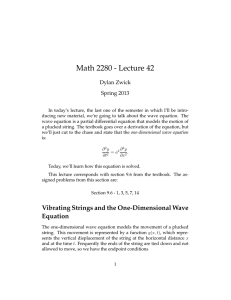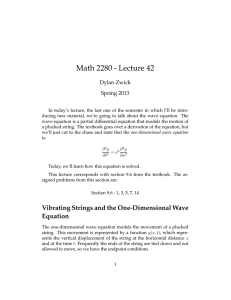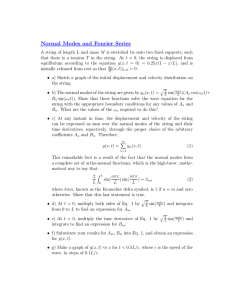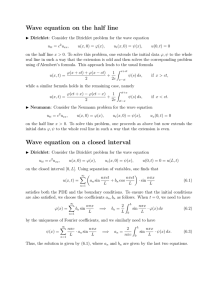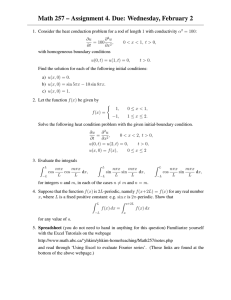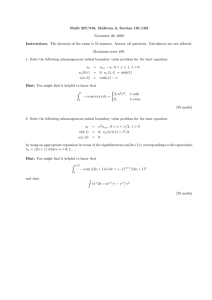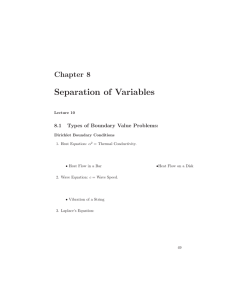Math 2280 - Lecture 42 Dylan Zwick Fall 2013
advertisement
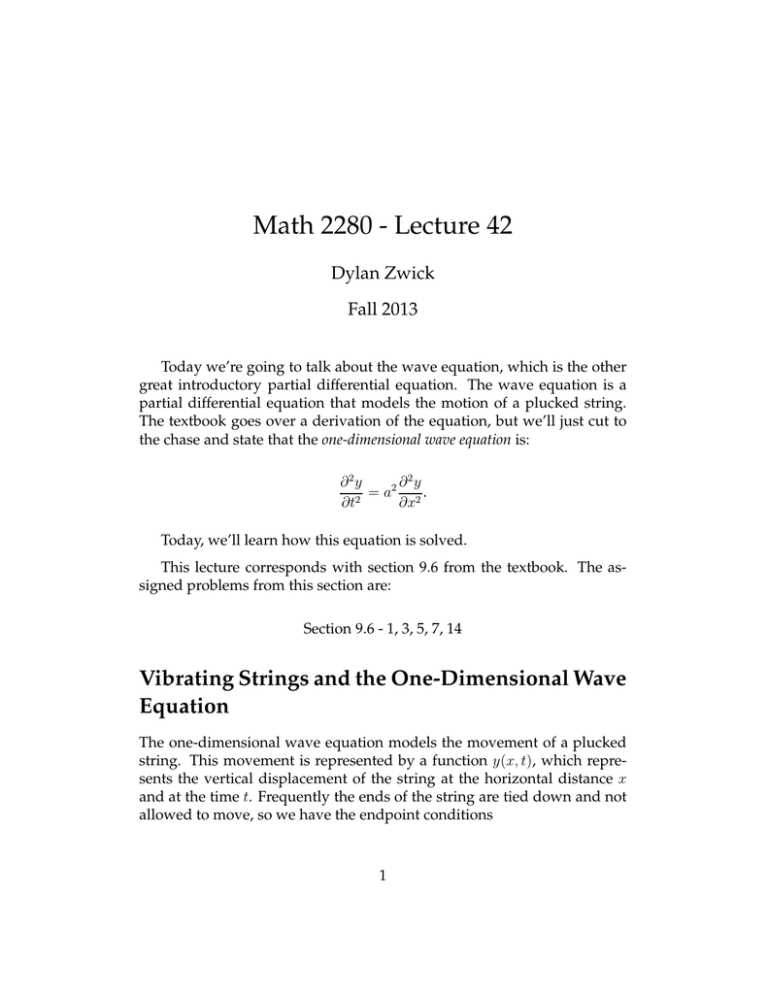
Math 2280 - Lecture 42 Dylan Zwick Fall 2013 Today we’re going to talk about the wave equation, which is the other great introductory partial differential equation. The wave equation is a partial differential equation that models the motion of a plucked string. The textbook goes over a derivation of the equation, but we’ll just cut to the chase and state that the one-dimensional wave equation is: 2 ∂2y 2∂ y =a . ∂t2 ∂x2 Today, we’ll learn how this equation is solved. This lecture corresponds with section 9.6 from the textbook. The assigned problems from this section are: Section 9.6 - 1, 3, 5, 7, 14 Vibrating Strings and the One-Dimensional Wave Equation The one-dimensional wave equation models the movement of a plucked string. This movement is represented by a function y(x, t), which represents the vertical displacement of the string at the horizontal distance x and at the time t. Frequently the ends of the string are tied down and not allowed to move, so we have the endpoint conditions 1 y(0, t) = y(L, t) = 0. If we specify the initial position of the string, y(x, 0) = f (x), and the initial velocity yt (x, 0) = g(x) then we have a boundary value problem that we’d like to solve. Bringing this all together, we want to solve the boundary value problem 2 ∂2y 2∂ y = a (0 < x < l, t > 0); ∂t2 ∂x2 y(0, t) = y(L, t) = 0, y(x, 0) = f (x) (0 < x < L), yt (x, 0) = g(x) (0 < x < L). Separation of Variables Our method is the same method we used for solving the heat equation. Namely, we use separation of variables. So, we assume that our solution is of the form y(x, t) = X(x)T (t). If we plug this into our differential equation we get the relation X ′′ T ′′ = 2 . X aT This is only possible if both functions are equal to the same constant. So, we write T ′′ X ′′ = 2 = −λ X aT 2 for some constant λ. So, our partial differential equation separates into the two ordinary differential equations X ′′ + λX = 0, and T ′′ + λa2 T = 0. Finding the Solutions The endpoint conditions require X(0) = X(L) = 0 if T (t) is non-trivial, and so X(x) must satisfy the eigenvalue problem we’re grown to know and love X ′′ + λX = 0, X(0) = X(L) = 0. We solved this two lectures ago. The eigenvalues of this problem are the numbers n2 π 2 λn = 2 , L where n is a positive integer. The associated eigenfunctions are Xn (x) = sin nπx . L Now, what about the functions Tn (t)? Well, we first note that we can solve our boundary value problem if we can find two solutions, one to the boundary value problem 3 ytt = a2 yxx ; y(0, t) = y(L, t) = 0, y(x, 0) = f (x), yt (x, 0) = 0, and the other to the boundary value problem ytt = a2 yxx ; y(0, t) = y(L, t) = 0, y(x, 0) = 0, yt (x, 0) = g(x). If we call these two solutions yA and yB then our final solution will be y = yA + yB . If we’re solving for yA then our equation for Tn (t) will be Tn′′ + n2 π 2 Tn = 0, L2 with initial condition Tn′ (0) = 0. The general solution to this differential equation will be a multiple of Tn (t) = cos nπat . L Our final solution for yA will then be yA (x, t) = ∞ X An Xn (x)Tn (t) = n=1 ∞ X n=1 We need the coefficients An to satisfy 4 An cos nπx nπat sin . L L ∞ X yA (x, 0) = An sin n=1 nπx = f (x), L and so 2 An = L Z L f (x) sin 0 nπx dx. L As for the solution yB , the ODE for Tn (t) here will be Tn′′ + a2 n2 π 2 Tn = 0, L2 with initial condition Tn (0) = 0. Runnning through our standard arguments we get that our final solution will be: yB (x, t) = ∞ X Bn sin n=1 nπat nπx sin , L L with 2 Bn = nπa Z L g(x) sin 0 nπx dx. L Recall g(x) is the initial velocity of the string yt (x, 0) = g(x). Our final solution will be y(x, t) = yA (x, t) + yB (x, t). Example - Suppose we have a string of length L whose initial velocity is 0, and whose initial position is given by f (x) = bx 0 ≤ x ≤ L/2 . b(L − x) L/2 ≤ x ≤ L Find y(x, t) for this system. 5 Room for the example problem. 6 The d’Alembert Form OK, now we’ve learned the Fourier series way of solving the wave equation. Let’s learn the easy way. Suppose the initial velocity of our string is yt (x, 0) = 0, and the initial position is given by y(x, 0) = f (x). Then a long time ago a smart guy named d’Alembert figured out that, if F (x) is the odd extension of period 2L of the initial position function f (x), then 1 y(x, t) = [F (x + at) + F (x − at)] 2 satisfies our differential equation. Check it out, it works. So, what this looks like is our initial position function breaks up into two equal halves, and one half travels one way down the string, while the other half travels the other way. We can use some trigonometric substitutions (done in the book) to prove our Fourier series solution boils down to the d’Alembert form, or we can just stop to admire it’s simplicity. I vote for the latter. Notes on Homework Problems Problems 9.6.1, 9.6.3, 9.6.5, and 9.6.7 are all variations on the same theme. Namely, you’re given the wave equation and initial functions specifying position and velocity, and you need to solve the corresponding boundary value problem. All are similar to the example problem done in these notes. Problem 9.6.14 is a verification of the d’Alembert form. It should be pretty quick, but it’s also pretty cool. 7
